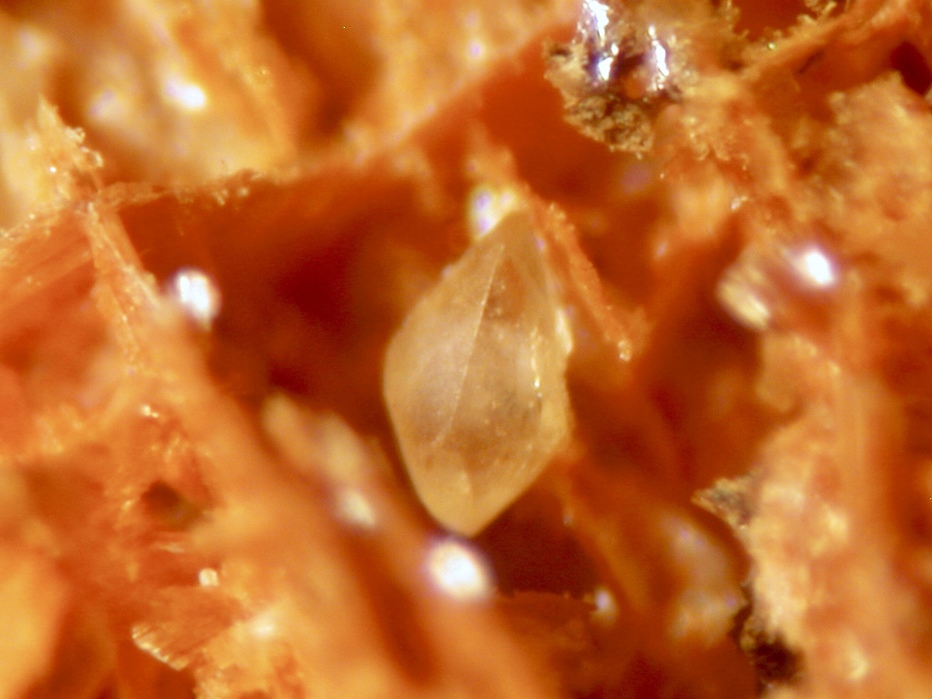Nizamoffite
A valid IMA mineral species
This page is currently not sponsored. Click here to sponsor this page.
About Nizamoffite
Formula:
Mn2+Zn2(PO4)2(H2O)4
Colour:
Colorless
Lustre:
Vitreous
Hardness:
3½
Specific Gravity:
3.00
Crystal System:
Orthorhombic
Member of:
Name:
In honor of James W. Nizamoff (b. 1971) in recognition of his research on pegmatite mineralogy in general, and especially on the phosphate mineralogy of the Palermo pegmatites at North Groton, New Hampshire. J. W. Nizamoff is one of the discoverers of the new mineral and provided the specimens used for its characterization.
Unique Identifiers
Mindat ID:
43593
Long-form identifier:
mindat:1:1:43593:8
GUID
(UUID V4):
(UUID V4):
c88d2536-4e08-498d-a960-57a3aec7c173
IMA Classification of Nizamoffite
Approved
First published:
2013
Classification of Nizamoffite
8.CA.30
8 : PHOSPHATES, ARSENATES, VANADATES
C : Phosphates without additional anions, with H2O
A : With small and large/medium cations
8 : PHOSPHATES, ARSENATES, VANADATES
C : Phosphates without additional anions, with H2O
A : With small and large/medium cations
Mineral Symbols
As of 2021 there are now IMA–CNMNC approved mineral symbols (abbreviations) for each mineral species, useful for tables and diagrams.
| Symbol | Source | Reference |
|---|---|---|
| Niz | IMA–CNMNC | Warr, L.N. (2021). IMA–CNMNC approved mineral symbols. Mineralogical Magazine, 85(3), 291-320. doi:10.1180/mgm.2021.43 |
Physical Properties of Nizamoffite
Vitreous
Transparency:
Transparent
Colour:
Colorless
Streak:
White
Hardness:
3½ on Mohs scale
Tenacity:
Brittle
Cleavage:
Perfect
Perfect on {010}, good on {100}, and fair on {001}.
Perfect on {010}, good on {100}, and fair on {001}.
Fracture:
Irregular/Uneven
Density:
3.00(1) g/cm3 (Measured) 2.961 g/cm3 (Calculated)
Optical Data of Nizamoffite
Type:
Biaxial (-)
RI values:
nα = 1.580 nβ = 1.590 nγ = 1.591
2V:
Measured: 28° (1), Calculated: 35°
Max Birefringence:
δ = 0.011

Image shows birefringence interference colour range (at 30µm thickness)
and does not take into account mineral colouration.
and does not take into account mineral colouration.
Surface Relief:
Moderate
Dispersion:
Strong, r < v.
Optical Extinction:
X = a; Y = c; Z = b.
Pleochroism:
Non-pleochroic
Chemistry of Nizamoffite
Mindat Formula:
Mn2+Zn2(PO4)2(H2O)4
Crystallography of Nizamoffite
Crystal System:
Orthorhombic
Class (H-M):
mmm (2/m 2/m 2/m) - Dipyramidal
Space Group:
Pbcm
Cell Parameters:
a = 10.6530 Å, b = 18.4778 Å, c = 5.0583 Å
Ratio:
a:b:c = 0.577 : 1 : 0.274
Unit Cell V:
995.70 ų (Calculated from Unit Cell)
Z:
4
Morphology:
Prismatic crystals, elongated and striated along [001]. Forms include {100}, {010}, {230}, {011}, {031}, and {111}.
Comment:
Space group Pnma
Crystal Structure
Load
Unit Cell | Unit Cell Packed
2x2x2 | 3x3x3 | 4x4x4
Unit Cell | Unit Cell Packed
2x2x2 | 3x3x3 | 4x4x4
Show
Big Balls | Small Balls | Just Balls | Spacefill
Polyhedra Off | Si Polyhedra | All Polyhedra
Remove metal-metal sticks
Big Balls | Small Balls | Just Balls | Spacefill
Polyhedra Off | Si Polyhedra | All Polyhedra
Remove metal-metal sticks
Display Options
Black Background | White Background
Perspective On | Perspective Off
2D | Stereo | Red-Blue | Red-Cyan
Black Background | White Background
Perspective On | Perspective Off
2D | Stereo | Red-Blue | Red-Cyan
View
CIF File Best | x | y | z | a | b | c
CIF File Best | x | y | z | a | b | c
Rotation
Stop | Start
Stop | Start
Labels
Console Off | On | Grey | Yellow
Console Off | On | Grey | Yellow
Data courtesy of the American Mineralogist Crystal Structure Database. Click on an AMCSD ID to view structure
| ID | Species | Reference | Link | Year | Locality | Pressure (GPa) | Temp (K) |
|---|---|---|---|---|---|---|---|
| 0020015 | Nizamoffite | Kampf A R, Falster A U, Simmons W B, Whitmore R W (2013) Nizamoffite, Mn2+Zn2(PO4)2(H2O)4, the Mn analogue of hopeite from the Palermo No. 1 pegmatite, North Groton, New Hampshire American Mineralogist 98 1893-1898 | 2013 | the Palermo No. 1 pegmatite, North Groton, New Hampshire, USA | 0 | 293 |
CIF Raw Data - click here to close
X-Ray Powder Diffraction
Powder Diffraction Data:
| d-spacing | Intensity |
|---|---|
| 9.27 Å | (71) |
| 4.62 Å | (37) |
| 4.43 Å | (24) |
| 3.424 Å | (52) |
| 2.873 Å | (100) |
| 2.644 Å | (36) |
| 2.540 Å | (33) |
| 1.953 Å | (36) |
Comments:
From Type Description.
Geological Environment
Paragenetic Mode(s):
| Paragenetic Mode | Earliest Age (Ga) |
|---|---|
| Stage 4b: Highly evolved igneous rocks | >3.0 |
| 34 : Complex granite pegmatites |
Type Occurrence of Nizamoffite
General Appearance of Type Material:
Prisms up to 1 mm in length and 0.5 mm in diameter. The prisms are elongated and lightly striated parallel to [001].
Place of Conservation of Type Material:
Natural History Museum of Los Angeles County, Los Angeles, California, USA, catalogue numbers 64009 and 64010.
Geological Setting of Type Material:
Pegmatite secondary alteration of primary triphylite and associated sphalerite.
Associated Minerals at Type Locality:
Synonyms of Nizamoffite
Relationship of Nizamoffite to other Species
Member of:
Other Members of this group:
| Arsenohopeite | Zn3(AsO4)2 · 4H2O | Orth. mmm (2/m 2/m 2/m) : Pnma |
| Davidlloydite | Zn3(AsO4)2 · 4H2O | Tric. 1 : P1 |
| Hopeite | ZnZn2(PO4)2 · 4H2O | Orth. mmm (2/m 2/m 2/m) : Pnma |
| Parahopeite | Zn3(PO4)2 · 4H2O | Tric. 1 : P1 |
| Sergeysmirnovite | MgZn2(PO4)2 · 4H2O | Orth. mmm (2/m 2/m 2/m) : Pnma |
| Unnamed (Mg-analogue of Hopeite) | Mg3(PO4)2 · 4H2O |
Common Associates
Associated Minerals Based on Photo Data:
Related Minerals - Strunz-mindat Grouping
| 8.CA. | Davidlloydite | Zn3(AsO4)2 · 4H2O |
| 8.CA. | Apexite | NaMg(PO4) · 9H2O |
| 8.CA. | Brandãoite | BeAl2(PO4)2(OH)2(H2O)5 |
| 8.CA.05 | Fransoletite | Ca3Be2(PO4)2(PO3OH)2 · 4H2O |
| 8.CA.05 | Parafransoletite | Ca3Be2(PO4)2(PO3OH)2 · 4H2O |
| 8.CA.10 | Ehrleite | Ca4Be3Zn2(PO4)6 · 9H2O |
| 8.CA.15 | Faheyite | Be2Mn2+Fe3+2(PO4)4 · 6H2O |
| 8.CA.20 | Gainesite | Na(Na,K)(Be,Li)Zr2(PO4)4 · 1.5-2H2O |
| 8.CA.20 | Mccrillisite | NaCs(Be,Li)Zr2(PO4)4 · 1-2H2O |
| 8.CA.20 | Selwynite | NaK(Be,Al)Zr2(PO4)4 · 2H2O |
| 8.CA.25 | Pahasapaite | Li8(Ca,Li,K)10.5Be24(PO4)24 · 38H2O |
| 8.CA.30 | Hopeite | ZnZn2(PO4)2 · 4H2O |
| 8.CA.30 | Arsenohopeite | Zn3(AsO4)2 · 4H2O |
| 8.CA.30 | Unnamed (Mg-analogue of Hopeite) | Mg3(PO4)2 · 4H2O |
| 8.CA.35 | Warikahnite | Zn3(AsO4)2 · 2H2O |
| 8.CA.40 | Phosphophyllite | Zn2Fe(PO4)2 · 4H2O |
| 8.CA.42 | Steinmetzite | Zn2Fe3+(PO4)2(OH) · 3H2O |
| 8.CA.45 | Parascholzite | CaZn2(PO4)2 · 2H2O |
| 8.CA.45 | Scholzite | CaZn2(PO4)2 · 2H2O |
| 8.CA.50 | Keyite | Cu2+3Zn4Cd2(AsO4)6 · 2H2O |
| 8.CA.55 | Pushcharovskite | K0.6Cu18[AsO2(OH)2]4[AsO3OH]10(AsO4)(OH)9.6 · 18.6H2O |
| 8.CA.60 | Prosperite | Ca2Zn4(AsO4)4 · H2O |
| 8.CA.65 | Gengenbachite | KFe3+3(PO3OH)4[PO2(OH)2]2 · 6H2O |
| 8.CA.70 | Parahopeite | Zn3(PO4)2 · 4H2O |
| 8.CA.70 | Reaphookhillite | MgZn2(PO4)2 · 4H2O |
| 8.CA.75 | Stergiouite | CaZn2(AsO4)2 · 4H2O |
| 8.CA.80 | Limousinite | BaCa[Be4P4O16] · 6H2O |
| 8.CA.85 | Minjiangite | BaBe2(PO4)2 |
| 8.CA.85 | Wilancookite | (Ba5Li2◻)Ba6Be24P24O96 · 26H2O |
Fluorescence of Nizamoffite
none
Other Information
Notes:
Dissolves readily in cold, dilute HCl.
Health Risks:
No information on health risks for this material has been entered into the database. You should always treat mineral specimens with care.
Internet Links for Nizamoffite
mindat.org URL:
https://www.mindat.org/min-43593.html
Please feel free to link to this page.
Please feel free to link to this page.
Search Engines:
External Links:
Mineral Dealers:
References for Nizamoffite
Reference List:
Williams, P. A., Hatert, F., Pasero, M., Mills, S. J. (2013) IMA Commission on New Minerals, Nomenclature and Classification. CNMNC Newsletter No. 15. Mineralogical Magazine, 77 (1) 1-12 doi:10.1180/minmag.2013.077.1.01
Kampf, A. R., Falster, A. U., Simmons, W. B., Whitmore, R. W. (2013) Nizamoffite, Mn2+Zn2(PO4)2(H2O)4, the Mn analogue of hopeite from the Palermo No. 1 pegmatite, North Groton, New Hampshire. American Mineralogist, 98 (10) 1893-1898 doi:10.2138/am.2013.4491
Keck, Erich, Grey, Ian E., MacRae, Colin M., Boer, Stephanie, Hochleitner, Rupert, Rewitzer, Christian, Mumme, William G., Glenn, A. Matt, Davidson, Cameron (2022) New secondary phosphate mineral occurrences and their crystal chemistry, at the Hagendorf Süd pegmatite, Bavaria. European Journal of Mineralogy, 34 (5) 439-450 doi:10.5194/ejm-34-439-2022
Localities for Nizamoffite
Locality List
 - This locality has map coordinates listed.
- This locality has map coordinates listed.
 - This locality has estimated coordinates.
ⓘ - Click for references and further information on this occurrence.
? - Indicates mineral may be doubtful at this locality.
- This locality has estimated coordinates.
ⓘ - Click for references and further information on this occurrence.
? - Indicates mineral may be doubtful at this locality.
 - Good crystals or important locality for species.
- Good crystals or important locality for species.
 - World class for species or very significant.
(TL) - Type Locality for a valid mineral species.
(FRL) - First Recorded Locality for everything else (eg varieties).
- World class for species or very significant.
(TL) - Type Locality for a valid mineral species.
(FRL) - First Recorded Locality for everything else (eg varieties).
All localities listed without proper references should be considered as questionable.
Germany | |
| Keck et al. (2022) |
USA (TL) | |
| Kampf et al. (2013) |
| Jason Smith collection |
Quick NavTopAbout NizamoffiteUnique IdentifiersIMA Classification Classification Mineral SymbolsPhysical Properties Optical Data Chemistry Crystallography Crystal StructureX-Ray Powder DiffractionGeological EnvironmentType Occurrence SynonymsRelationshipsCommon AssociatesStrunz-MindatFluorescence Other InformationInternet Links References Localities Locality List





 symbol to view information about a locality.
The
symbol to view information about a locality.
The 



Foote Lithium Co. Mine, Kings Mountain, Cleveland County, North Carolina, USA